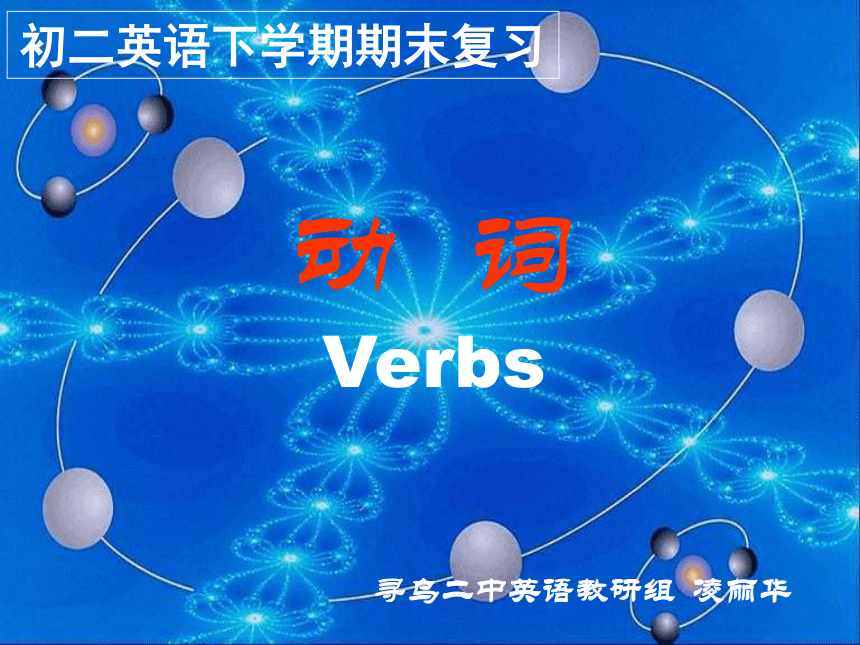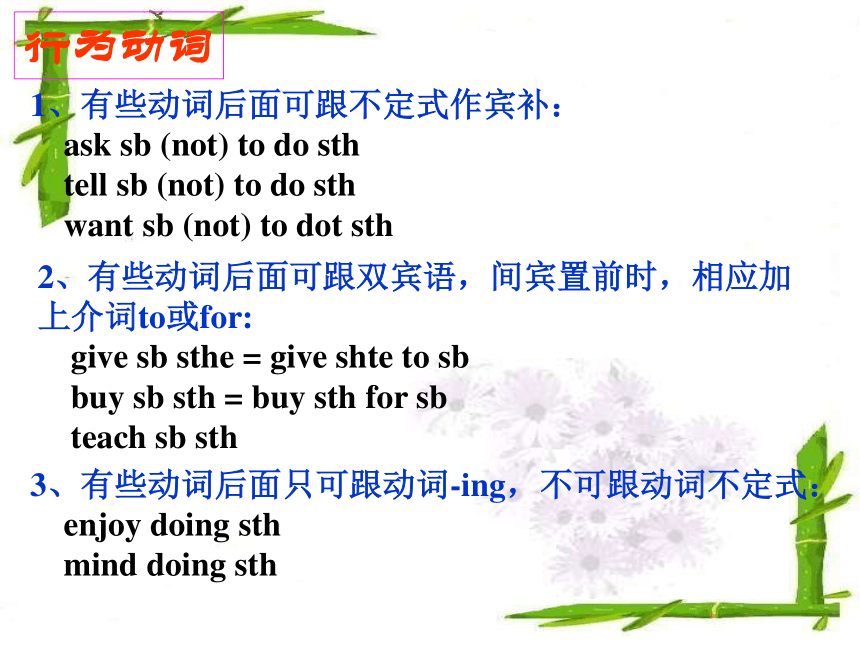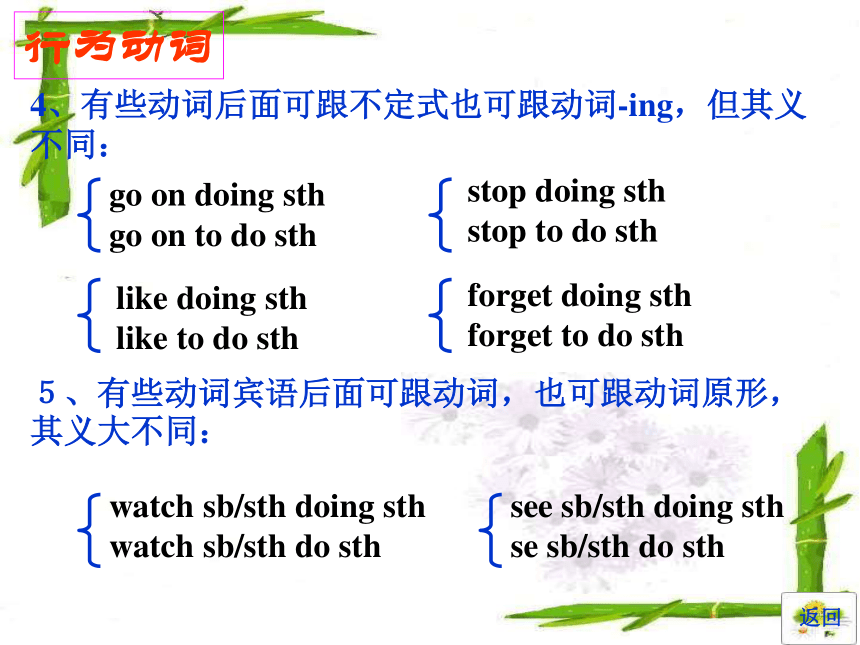英语动词复习课件
图片预览






文档简介
课件12张PPT。初二英语下学期期末复习动 词Verbs寻乌二中英语教研组 凌丽华练习巩固复习导入行为
动词动词
种类情态动词复习导入返回行为动词
Action Verbs系 动 词
Link Verbs助 动 词
Auxiliary Verbs情态动词
Modal Verbs含有实在的意义,表示动作或状态,在句中能独立作谓语。如:put run laugh本身有一定的词义,但不能独立作谓语,必须与表语一起构成谓语。如:be look get本身没有词义,不能独立作谓语,只能和主要动词一起构成谓语动词,表示否定、疑问、时态或其他语法形式。如:be does did本身有一动的意义,但不能独立作谓语,只能和主要动词一起构成谓语动词,表示说话人的语气和情态。情态动词没有人称和数的变化。如:can must mayShe has some bananas.
They eat a lot of potatoes.
I’m reading an English book now.His father is a teacher.
Twins usually look the same.
The teacher became angry.He doesn’t speak English.(否定)
We are playing basketball.
(进行时态)
Do you have a brother?(疑问)You can keep them for two weeks.
May I smoke here?
We must go new.动词种类返回1、有些动词后面可跟不定式作宾补:
ask sb (not) to do sth
tell sb (not) to do sth
want sb (not) to dot sth2、有些动词后面可跟双宾语,间宾置前时,相应加上介词to或for:
give sb sthe = give shte to sb
buy sb sth = buy sth for sb
teach sb sth3、有些动词后面只可跟动词-ing,不可跟动词不定式:
enjoy doing sth
mind doing sth行为动词4、有些动词后面可跟不定式也可跟动词-ing,但其义不同:go on doing sth
go on to do sthforget doing sth
forget to do sthlike doing sth
like to do sthstop doing sth
stop to do sth5、有些动词宾语后面可跟动词,也可跟动词原形,其义大不同:watch sb/sth doing sth
watch sb/sth do sthsee sb/sth doing sth
se sb/sth do sth行为动词返回情态动词 特点:情态动词表示说话人对某一动作或状态的态度,认为“可能”、“应当”、“必要”等,但本身词义不完全,不能单独作谓语动词,必须和不带”to”的动词不定式(即动词原形)连用。情态动词没有人称和数的变化。朗读时,情态动词的肯定式一般不重读,有些情态动词没有过去式,如must;有些有过去式,如:can—could,may—might,have to –had to等。
情态动词的否定式一般是在它们的后面加否定词构成,但have to需借助动词does、do、 did not。1、can和could:表示“能力”、“许可”、“可能性”。
口语中的可替may,而may较为正式,could可替can,使语气更委婉,
eg :Some of us can speak Russian now,but we couldn’t speak it 5 years ago.
Can/could I borrow these books?
I thought the story could not be true.2、may:
(1)表示讲可或征求对方许可,有“可以”之意,但用作此意时它的否定形式用may not,但表示“不允许”、“禁止”、“阻止”等意思时用mustn’t+代替:
例:you may go now.
May I play games in class?
No,you mustn’t.
(2)还表示可能性,有“或许”、“可能”的意思
eg:He may be English,but I’m not sure.情态动词情态动词3、must和have to返回1. I take the newspaper away?
No, you mustn’t.You read it only here.
A.Must,can B.May,can C.Need,must D.Must,must
you sing the song? Yes,I .but It wo years ago.
A. B. C. D.
3.Must I reture the book at once?
No,you .but you teturn it after school.
A.needn’t,must B.mustn’t,can C.mustn’t,may D.can’t,need
4.Our teacher often tells us in the sereet.
A.no play B.not playing C.not to play D.not to playing
5.My mother is out,so I look after my little sister.
A.may B.must C.have to D.can
6.The students stopped when the teacher came in.
A.to talk B.talking C.talks D.talked
练习巩固BBBBBB练习巩固7.Everybody is busy ready for the exams.
A.get B.to get C.getting D.get
8.Please don’t forget the door when you leave.
A.pocked B.lock C.to lock D.locking
9.Please walk fast, we’ll be late.
A.or B.and C.so D.then
10.The old lady saw me the pen on the floor.
A.dropped B.drop C.dropping D.to drop
11.I saw toe old woman here when I was walking .
A.sit,pass B.sitting,past C.sitting,pass D.sit,past
12. the morning of september,our school begins.
A.In B.On C.At D.ToBBBBBBGood-bye!
动词动词
种类情态动词复习导入返回行为动词
Action Verbs系 动 词
Link Verbs助 动 词
Auxiliary Verbs情态动词
Modal Verbs含有实在的意义,表示动作或状态,在句中能独立作谓语。如:put run laugh本身有一定的词义,但不能独立作谓语,必须与表语一起构成谓语。如:be look get本身没有词义,不能独立作谓语,只能和主要动词一起构成谓语动词,表示否定、疑问、时态或其他语法形式。如:be does did本身有一动的意义,但不能独立作谓语,只能和主要动词一起构成谓语动词,表示说话人的语气和情态。情态动词没有人称和数的变化。如:can must mayShe has some bananas.
They eat a lot of potatoes.
I’m reading an English book now.His father is a teacher.
Twins usually look the same.
The teacher became angry.He doesn’t speak English.(否定)
We are playing basketball.
(进行时态)
Do you have a brother?(疑问)You can keep them for two weeks.
May I smoke here?
We must go new.动词种类返回1、有些动词后面可跟不定式作宾补:
ask sb (not) to do sth
tell sb (not) to do sth
want sb (not) to dot sth2、有些动词后面可跟双宾语,间宾置前时,相应加上介词to或for:
give sb sthe = give shte to sb
buy sb sth = buy sth for sb
teach sb sth3、有些动词后面只可跟动词-ing,不可跟动词不定式:
enjoy doing sth
mind doing sth行为动词4、有些动词后面可跟不定式也可跟动词-ing,但其义不同:go on doing sth
go on to do sthforget doing sth
forget to do sthlike doing sth
like to do sthstop doing sth
stop to do sth5、有些动词宾语后面可跟动词,也可跟动词原形,其义大不同:watch sb/sth doing sth
watch sb/sth do sthsee sb/sth doing sth
se sb/sth do sth行为动词返回情态动词 特点:情态动词表示说话人对某一动作或状态的态度,认为“可能”、“应当”、“必要”等,但本身词义不完全,不能单独作谓语动词,必须和不带”to”的动词不定式(即动词原形)连用。情态动词没有人称和数的变化。朗读时,情态动词的肯定式一般不重读,有些情态动词没有过去式,如must;有些有过去式,如:can—could,may—might,have to –had to等。
情态动词的否定式一般是在它们的后面加否定词构成,但have to需借助动词does、do、 did not。1、can和could:表示“能力”、“许可”、“可能性”。
口语中的可替may,而may较为正式,could可替can,使语气更委婉,
eg :Some of us can speak Russian now,but we couldn’t speak it 5 years ago.
Can/could I borrow these books?
I thought the story could not be true.2、may:
(1)表示讲可或征求对方许可,有“可以”之意,但用作此意时它的否定形式用may not,但表示“不允许”、“禁止”、“阻止”等意思时用mustn’t+代替:
例:you may go now.
May I play games in class?
No,you mustn’t.
(2)还表示可能性,有“或许”、“可能”的意思
eg:He may be English,but I’m not sure.情态动词情态动词3、must和have to返回1. I take the newspaper away?
No, you mustn’t.You read it only here.
A.Must,can B.May,can C.Need,must D.Must,must
you sing the song? Yes,I .but It wo years ago.
A. B. C. D.
3.Must I reture the book at once?
No,you .but you teturn it after school.
A.needn’t,must B.mustn’t,can C.mustn’t,may D.can’t,need
4.Our teacher often tells us in the sereet.
A.no play B.not playing C.not to play D.not to playing
5.My mother is out,so I look after my little sister.
A.may B.must C.have to D.can
6.The students stopped when the teacher came in.
A.to talk B.talking C.talks D.talked
练习巩固BBBBBB练习巩固7.Everybody is busy ready for the exams.
A.get B.to get C.getting D.get
8.Please don’t forget the door when you leave.
A.pocked B.lock C.to lock D.locking
9.Please walk fast, we’ll be late.
A.or B.and C.so D.then
10.The old lady saw me the pen on the floor.
A.dropped B.drop C.dropping D.to drop
11.I saw toe old woman here when I was walking .
A.sit,pass B.sitting,past C.sitting,pass D.sit,past
12. the morning of september,our school begins.
A.In B.On C.At D.ToBBBBBBGood-bye!
同课章节目录
- 词法
- 名词
- 动词和动词短语
- 动词语态
- 动词时态
- 助动词和情态动词
- 非谓语动词
- 冠词
- 代词
- 数词和量词
- 形容词副词及其比较等级
- 介词和介词短语
- 连词和感叹词
- 构词法
- 相似、相近词比较
- 句法
- 陈述句
- 一般疑问句和否定疑问句
- 特殊疑问句及选择疑问句
- 反意疑问句
- 存在句(There be句型)
- 宾语从句
- 定语从句
- 状语从句
- 主谓一致问题
- 简单句
- 并列句
- 复合句
- 主谓一致
- 主、表语从句
- 名词性从句
- 直接引语和间接引语
- 虚拟语气
- 感叹句
- 强调句
- 倒装句
- 祈使句
- 句子的成分
- 句子的分类
- 题型专区
- 单项选择部分
- 易错题
- 完形填空
- 阅读理解
- 词汇练习
- 听说训练
- 句型转换
- 补全对话
- 短文改错
- 翻译
- 书面表达
- 任务型阅读
- 语法填空
- 其他资料
